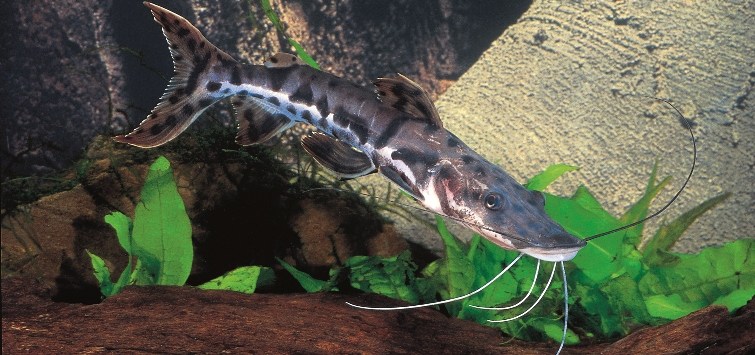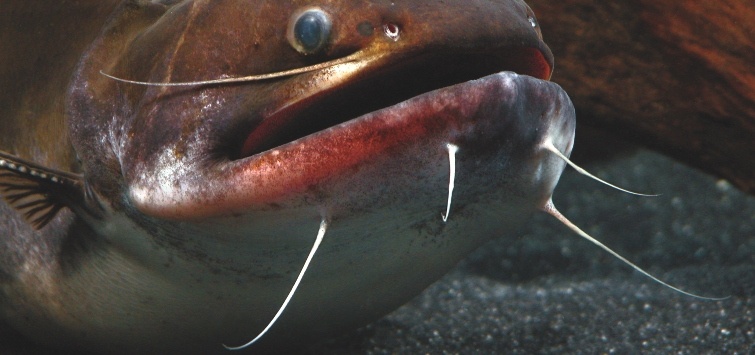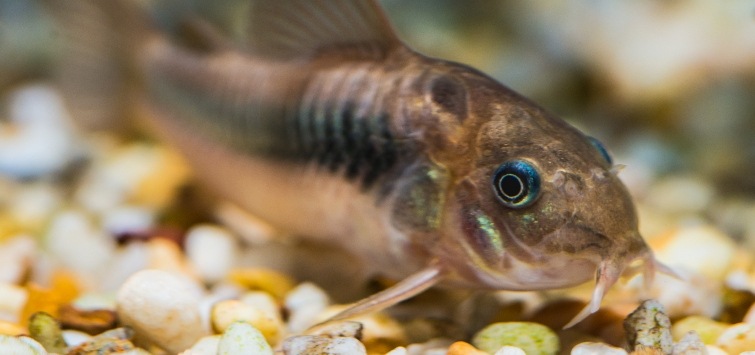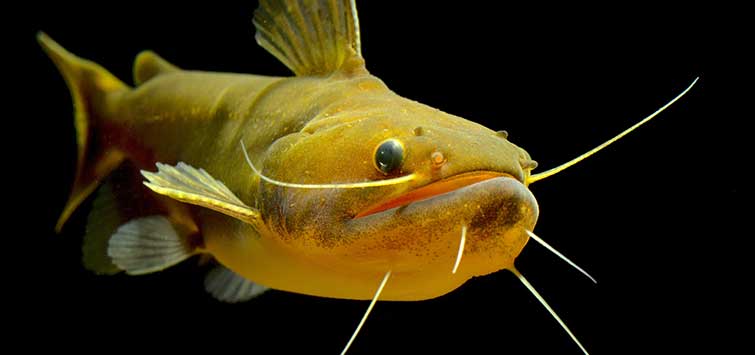What Do Catfish Eat? Feeding Strategies Explained
With more than 3,000 described species, the order that comprises the catfishes, Siluriformes, is among the most diverse orders of vertebrates, representing over a quarter of freshwater fishes. Indeed, the order is so varied that about 5 percent of all vertebrate animal species are catfishes. With so many different kinds, it should come as no surprise that catfishes are also incredibly diverse, with huge variances in virtually every aspect, from size to ecological niche to feeding strategy.
So, what do catfish eat? Almost every feeding strategy employed by fishes is found among catfishes, which include both the devout predators and obligate herbivores, as well as everything in between. This can present a challenge to the aquarist, who may be at a loss finding foods for a newly acquired catfish, particularly if it is among the hundreds that are rarely seen in the hobby. But by looking at the morphology of each type of catfish, you can gain an understanding of their natural feeding strategy, and therefore the foods they need to thrive in the aquarium.
Mouth Placement

The placement of the mouth is one of the simplest and most obvious morphological feeding features and may be described as terminal, superior, or subterminal (inferior). The vast majority of fishes have a terminal mouth, located at the end of the face. The subterminal position is a downturned mouth, which is also fairly common among catfishes. The superior mouth structure is an upturned mouth, mostly used for feeding on items above the fish or at the water’s surface.
The subterminal position is best represented by the familiar Corydoras and its relatives, as well as the various members of the family Loricariidae, which tend to feed on items located beneath them including insect larvae in sand or mud or, as in the case of many loricariids, things growing on larger structures, such as algae. Some fish with downward-facing mouths will also feed on larger items located beneath them, such as snails, shrimp, bivalves, and mollusks.
The terminal mouth is also well represented among catfishes, which feed on items located in front of them and tend to be predatory. However, as this mouth structure is also seen on plant-eating fishes, this is not always the rule. The various wood cats, such as Trachelyichthys spp. and Centromochlus spp., have terminal mouths, as do many larger catfishes, such as the Pseudoplatystoma.
The superior mouth position is somewhat uncommon among catfish. It is probably best shown in other groups of fish like hatchetfish (e.g., Carnegiella spp.), in which the upturned mouth is used to skim insects from the surface of the water. At first glance, this would seem to be an unlikely position for the mouth of a catfish, but it allows the fish to readily feed on items positioned above it in the water column, and many ambush predators have superior mouth structures. Among catfish, many members of the family Pseudopimelodidae have superior mouths, an indication of their status as primary predators, often lying in wait at the bottom for an unwitting meal to swim overhead. Similarly, the upturned, smiling mouth of the gulper catfish (Asterophysus batrachus) indicates a predatory fish that will typically strike from below.
On the other side of the spectrum, an argument can be made for the superior mouth position among many upside-down catfishes, such as Mystus leucophasis and Synodontis nigrita. While their mouths are technically located in a subterminal position, because these fish spend much of their time upside-down, the mouth effectively acts as a superior-positioned mouth. In the wild, this upside-down behavior allows them to skim food from the undersurfaces of stone outcrops, branches, and even the surface—a behavior commonly seen when these fish skim the aquarium’s surface for flake food. Indeed, the upside-down superior mouth position also allows Mystus to be an effective predator of smaller fishes in the aquarium.
Mouth Shape

The shape and relative size of a fish’s mouth can similarly tell a lot about its diet, particularly in combination with its position. Additionally, the mouth shape can provide clues about a fish’s habitat. Among catfishes, this shape tends to be fairly normalized, with most catfishes having a nonspecialized mouth. As for size, large mouths generally indicate that the fish eats large foods.
Compare the mouths on the two previously mentioned upside-down catfishes. While their position and overall shape are quite similar, and, indeed, so are the habits of the two fishes, the mouth size is radically different. The Mystus catfish’s is wide in comparison to Synodontis nigrita’s—again, wide enough to accommodate its tankmates.
Many catfishes have a protrusible mouth, one that is capable of extending. This is well demonstrated among many larger cichlids, such as the basketmouths (Caquetaia spp.), or even among the various American bass (Micropterus spp.). Among catfish, this indicates a predatory nature, though it is not always a fish-eating predator. A protrusible mouth allows the fish to vacuum in prey items. Often, this is combined with a subterminal mouth that is used to break apart mollusks or to assist in sifting the substrate.
Perhaps the best-known catfish mouth shape, however, is the specialized modification of a suckermouth, as with the various loricariids. This is one of the most versatile mouth structures, and while it’s easy to think of a suckermouth as a singular modification, there is a vast array of suckermouth types with varying tooth structures and functions.
A suckermouth is used for two basic purposes. One is to simply hold on: fish with a suckermouth may come from areas with high flow. For example, the African suckermouth catfishes of Chiloglanis are typically found in fast-moving waters, and without their suckermouths to anchor them to rocks and other substrate, they would soon find themselves downstream.
More often, though, the suckermouth is used for feeding. While we often think of suckermouth catfishes as being algae eaters, no doubt due to the common “pleco” types, these catfishes’ diets are varied and may also include wood, meat, and more. A suckermouth can be motile or fused in structure, may differ in size, and can have more development in the “lips,” all of which can provide additional clues as to the fish’s habitat and food needs.
Whiskers
One of the defining features of a catfish is its whiskers, but that term is misleading, as “whisker” technically refers to a growth of hair. Catfishes actually have barbels, and they’re similar to those found on various cyprinids. The barbels act as extensions of their olfactory sense, allowing them to “taste” and “smell” the world around them. They also have an obvious ability to detect touch and are used to sense the catfish’s environment.A catfish’s barbels can tell you a lot about the fish itself. The longer and more developed the barbels, the more the catfish is forced to depend on them versus its normal sense of sight. Longer barbels generally indicate a predatory fish, and we can roughly define “long barbels” as meaning longer than the head; if they were bent backward, they’d stretch beyond the gills.
While long barbels indicate predatory fish, they may not indicate a fish-eating predator. Brachysynodontis batensoda has long whiskers, with much development on them, as does Oxydoras niger. Yet, both of these fish would be among the few “big fish” I would ever put in a tank with smaller fish—while both are predatory, they tend to ignore other fish. Oxydoras niger uses its developed whiskers to sift through mud and sand. Its subterminal mouth position and protrusible lips should be further clues to this catfish’s diet: invertebrates found in the substrate. Similarly, the long whiskers of Brachysynodontis are used to detect concentrations of plankton, not fish prey. Its relatively small mouth indicates a fish not apt to eat others.
Two commonly encountered long-whiskered catfish often leave aquarists with fairly negative feelings about keeping cat species outside of Corydoras. Both Pimelodella pictus and the shark cat Ariopsis seemanni are often sold as “good scavengers,” but they share several features indicating otherwise. Both fish have very long whiskers, often as long as the rest of their bodies. These whiskers are used for finding prey. Both have terminal mouths, indicating that they eat things that are in front of them. Both have large, wideset mouths, indicating that they eat large items.
Fish with moderately long barbels use them to find food but also depend upon vision for the same. As such, these catfish tend to be diurnal, or at least crepuscular. They tend to be predators but begin to lean more toward the omnivorous side of the spectrum. The most apparent of the medium-length-barbel fish is the familiar Corydoras. Their barbels are obvious upon examination (unless they’ve been kept in poor conditions), but a non-aquarist just glancing at a cory cat might not even see them. In the wild, these barbels are used to find small prey items, such as insect larvae, in the substrate. They’ll also eat algae, decaying vegetable matter, and anything else that those barbels tell them is edible. You’ll note a similar situation on many of the banjo catfish (e.g., Bunocephalus spp.). These fish live in leaf litter and hunt the small invertebrates that break it down. Fish with medium-length barbels are generally not preying on fast-moving items and as such as are not piscivores. However, there are notable exceptions.
The electric catfishes (e.g., Malapterurus electricus) have reasonably short barbels. They’re apparent, particularly given the size of the fish, but they certainly aren’t as long and developed as its predatory nature would seem to imply. These fish rely on their own special “radar” to detect their prey and their electric organs to stun it. The barbels are then used to home in on the stunned food item.
Finally, there are fish with short barbels or barbels that are not obvious. These include the various loricariids. Note that barbels should not be confused with structures like odontodes and bristles, which are common features of these fish. At most, a single pair of quite short barbels attached to the lips is found on these types of cats. While the barbels may be more noticeable, they’re short, undeveloped, and few. Catfish with minimal barbels tend to live in situations where barbels aren’t particularly needed. These are often fish that live surrounded by food and are herbivores, detritivores, or xylophores (wood eaters). Alternatively, they may be fish living in areas of extreme flow, where smelling food is not particularly helpful—all they would be able to discern is that it’s somewhere upstream.
While many of these catfishes are diurnal, many are also nocturnal—when you live surrounded by your food, you can get it virtually any time. These catfishes’ diets are all over the board, though they tend to lean toward the herbivorous side.
Teeth
William T. Innes, the famous aquarist of yesteryear, once quipped that “any fish with teeth is bound to use them.” This has been written into Innes Law and paraphrased in countless ways. As he stated, much of a fish’s diet can be inferred by looking at its teeth. While catfish lack the developed teeth of, say, the various Serrasalmidae—i.e., the sharp, vicious-looking teeth of the meat-eating piranhas and the flat, square teeth on the plant-eating pacus—a close examination of their mouths for toothlike structures can give hints as to what catfish eat.
This is particularly important among the family Loricariidae, a group that suffers from association with the familiar pleco. Often stereotyped as “algae eaters” in the aquarium trade, as readers of this column will know, many of these fish simply aren’t.
When examining the jaws of a member of the genus Leporacanthicus, one will notice two large fangs, giving rise to the common names of “vampire” or “Dracula” pleco. While these fangs are not used for bloodsucking, they do serve a function. Early references to this fish show the prejudice of “all plecos are algae eaters,” as it was theorized that they used these teeth to rasp algae from surfaces. Hilariously, I have even heard it suggested that the teeth are used like an ice axe, anchoring the pleco to surfaces in fast-moving water. Instead, we know that these teeth are used to gain access to large invertebrates, like snails, mussels, and (especially) shrimp.
Rows of teeth can be seen lining the suckermouth of any royal pleco (e.g., Panaque nigrolineatus). A close examination shows that rather than being the conical “fangs” of the vampire, these teeth are shaped like spoons. They very closely resemble the tines on a rough wood file and have a similar function. They’re used to rasp and grind, and royals are heavy xylophores that will make short work of driftwood in the aquarium. They’re also used to break apart stiff vegetable matter and will tear apart whole squash, broccoli, and other vegetables given to them. In the wild, they’ll likely eat similar fruits and vegetables, as well as other large plant matter. They’ll also use these rasps to remove algae from surfaces, including aquarium glass (or acrylic, which they can actually damage). I’ve also had these fish chew their way out of plastic fish bags!
The mouth of a bushynose pleco features fine, sandpaper-like teeth. These fish are particularly good algae eaters (to the point where I don’t see any reason for the larger plecos to ever be sold as algae eaters), and the teeth are used to remove algae from a variety of surfaces. As they are prominent and rough, it can also be inferred that they use them to do more than simply brush algae away. Bushynoses, like royals, will also eat wood, and they use their sandpaper mouths to grind the wood down.
If you grab a magnifying glass and examine the mouth of a Farlowella or Otocinclus spp. catfish, you’ll be hard-pressed to find teeth, and not just because of their very small mouths, which resemble, in miniature, the mouths of the big plecos (e.g., Pterygoplichthys). With almost no teeth, these mouths are used to scrape and pull algae from surfaces. To paraphrase Innes, a fish without teeth is unlikely to need them. These fish will eat simple prey, carrion, and, particularly, vegetable matter.

.png?h=595&iar=0&w=2781&hash=5FD5E69473BCC22199FBFA2FB71B6033)



